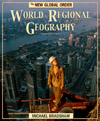Study the Key Terms listed in this chapter. Consult the glossary as needed. 1. Match the following political/economic terms with their descriptions. | ______Globalization | a. increasing demands for local decision-making | | ______Localization | b. increased production and trade based on new technologies | | ______Mini-system | c. artisans and ruling class supported by food surpluses | | ______Modernization | d. increasing interdependence and integration | | ______World regional empire | e. limited specialization and exchange |
2. Match the following groups of countries with their descriptions. | ______Core | a. dependent on some countries and some countries dependent on them | | ______First World | b. narrow range of products | | ______Periphery | c. has lost political influence since 1991 | | ______Second World | d. wide range of products and high wages | | ______Semi-periphery | e. poorer countries, mostly in the South | | ______Third World | f. leadership by the United States |
3. Match the following geographic terms with their descriptions. | ______Absolute location | a. studies natural environments | | ______Geography | b. studies linkages between places | | ______Human-environment relationships | c. often defined by latitude and longitude | | ______Human geography | d. studies interactions between human activities and the natural environment
| | ______Physical geography | e. how humans live in varied ways in different parts of Earth's surface | | ______Place | f. often defined by its level of interactions with other places | | ______Relative location | g. studies human activities | | ______Spatial analysis | h. points or areas |
4. Match the following terms related to regions with their descriptions. | ______Country | a. based on interactions and connections | | ______Formal region | b. often continental in size | | ______Functional region | c. distinctive subdivision of a country | | ______Local regions | d. based on internal characteristics | | ______Major world regions | e. studies differences among areas and the uniqueness of places | | ______Region | f. area of Earth's surface within which similar characteristics distinguish
it from other areas | | ______Regional geography | g. self-governing political entity |
5. Match the following economics terms with their descriptions. | ______Capitalism | a. geographic expansion of area having wealth accumulation and exchange
of goods | | ______Economic system | b. way that goods and services are produced, distributed, and consumed
| | ______Fordist regime | c. flexible manufacturing and quick marketing | | ______Industrial capitalism | d. now dominates the world economic system | | ______Mercantile capitalism | e. mass production of standardized products | | ______Post-Fordist production | f. much investment in manufacturing industries | | ______World economic system | g. local products are traded with other places and overseas |
6. Briefly describe each of the following terms: a. Culture __________________________________________________________________________ __________________________________________________________________________________ __________________________________________________________________________________ b. Global choke points _________________________________________________________________ ___________________________________________________________________________________ ___________________________________________________________________________________ c. Natural environment __________________________________________________________________ ____________________________________________________________________________________ ____________________________________________________________________________________ Study the major world regions listed and shown in this chapter. 1. Using matching, locate the following countries in their respective major
world region.
| Major World Regions: | Countries: | | a. Africa South of the Sahara | Afghanistan | | b. Anglo America | Libya | | c. Commonwealth of Independent States | Canada | | d. Eastern Asia | Mexico | | e. Europe | Cuba | | f. Latin America | Mongolia | | g. Northern Africa and Southwestern Asia | Ethiopia | | h. Southern Asia | New Zealand | | i. South Pacific | Finland | | Poland | | Greece | | Saudi Arabia | | Indonesia | | Sudan | | Japan | | Thailand | | Kazakhstan | | Turkey |
| 


 2002 McGraw-Hill Higher Education
2002 McGraw-Hill Higher Education